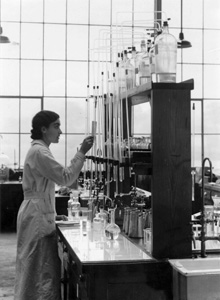Related Research Articles
The Chemical Society was a scientific society formed in 1841 by 77 scientists as a result of increased interest in scientific matters. Chemist Robert Warington was the driving force behind its creation.

William Hobson Mills FRS was a British organic chemist.

Ida Freund was the first woman to be a university chemistry lecturer in the United Kingdom. She is known for her influence on science teaching, particularly the teaching of women and girls. She wrote two key chemistry textbooks and invented the idea of baking periodic table cupcakes, as well as inventing a gas measuring tube, which was named after her.

Lucy Everest Boole FRIC was a British chemist and pharmacist who was the first woman to research pharmacy in England. She was the first female professor at the London School of Medicine for Women in the Royal Free Hospital, and the first female Fellow of the Royal Institute of Chemistry.

Grace Coleridge Frankland known as Mrs Percy FranklandnéeGrace Toynbee was an English microbiologist. She was one of the nineteen female scientists who wrote the 1904 petition to the Chemical Society to request that they should create some female fellows of the society.

Edith Ellen Humphrey was a British inorganic chemist who carried out pioneering work in co-ordination chemistry at the University of Zurich under Alfred Werner. She is thought to be the first British woman to obtain a doctorate in chemistry and the first chemist to synthesize a chiral inorganic complex.

Sibyl Taite Widdows (1876–1960) was a British Scientist and member of the Chemistry department at the London School of Medicine for Women for 40 years.
Mildred May Gostling, also published under her married name Mildred Mills, was an English chemist who completed research in carbohydrate chemistry. She was one of the nineteen signatories on a letter from professional female chemists to the Chemical Society requesting that women be accepted as Fellows to the Society.
Mary Beatrice Thomas was a lecturer in chemistry at Royal Holloway College and later at Girton College, Cambridge where she was also Director of Studies. She was a noted educator, co-editing a chemistry textbook written by Ida Freund, as well as being one of the nineteen signatories to a petition to the Chemical Society arguing for admission of women as Fellows of the Society.
Emily Jane Lloyd was an English chemist and one of the first women to become an Associate member of the Royal Institute of Chemistry.

Margaret Seward MBE became the earliest Chemist on staff at the Women's College, from 1896 to 1915. She became the pioneer woman to obtain a first class in the honour school of Natural Science and later received an MBE for her work on nutrition during World War I.
Katharine Isabella Williams was a British chemist who became a student, aged 29, at University College Bristol. She was known for her collaboration in the 1880s with Nobel prize winning Scottish chemist, William Ramsay and was also one of the signatories of the 1904 petition for the admission of women to the Chemical Society.
Dorothy Blanche Louisa Marshall was a British chemist who worked at Girton, Avery Hill and the National Physical Laboratory. In 1904, she signed a petition for women to be admitted as a Fellow of the Chemical Society.
Emily Comber Fortey was a British chemist and politician. She gained her B.Sc. in 1886 before working with Vladimir Markovnikov and Sydney Young on fractional distillation. In 1904, she was one of nineteen signatories on a petition to allow the admission of women to the Chemical Society.
Hilda Jane Hartle was a British chemist researcher and teacher. She was prominent in promoting the teaching of Chemistry to women and became known for her opposition to domestic science.
Clare de Brereton Evans was a scientist and academic who became the first woman to be awarded a doctorate in Chemistry (DSc). She was a pioneer translator of Meister Eckhart's German works.

Elizabeth Eleanor Field was a British chemist and the Head of Chemistry at Royal Holloway College for over nineteen years. She is also noted as one of the nineteen signatories of the 1904 petition which aimed to grant women the status of Fellows of the Chemical Society.
Katherine Alice Burke was a British chemist and one of the nineteen signatories of the 1904 petition to the Chemical Society.
Alice Emily Smith was a British chemist and one of the nineteen signatories of the 1904 petition to the Chemical Society.
Millicent Taylor FRSC MSc DSc was a chemist who, in 1904, was one of the nineteen women who petitioned to join the Chemical Society
References
- 1 2 3 4 5 6 7 8 9 10 Rayner-Canham, Marelene; Rayner-Canham, Geoff. "Pounding on the Doors: The Fight For Acceptance of British Women Chemists". Bull. Hist. Chem. 28 (2): 110–119.
- 1 2 3 4 5 6 7 8 Mason, Joan (1991). "A forty years' war". Chemistry in Britain: 233–238.
- ↑ Creese, Mary R. S. (5 January 2009). "British women of the nineteenth and early twentieth centuries who contributed to research in the chemical sciences". The British Journal for the History of Science. 24 (3): 275–305. doi: 10.1017/S0007087400027370 . PMID 11622943.
- ↑ Rayner-Canham, Marelene Rayner-Canham, Geoff (2008). Chemistry was their life : pioneer British women chemists, 1880-1949. London: Imperial College Press. pp. 64–68. ISBN 978-1860949869.
{{cite book}}: CS1 maint: multiple names: authors list (link) - ↑ "Proceedings of the Chemical Society, Vol. 24, No. 349". Proceedings of the Chemical Society (London). 24 (349): 277. 1908. doi:10.1039/PL9082400277.
- ↑ "Dr Ida Smedley | 175 Faces of Chemistry". www.rsc.org.